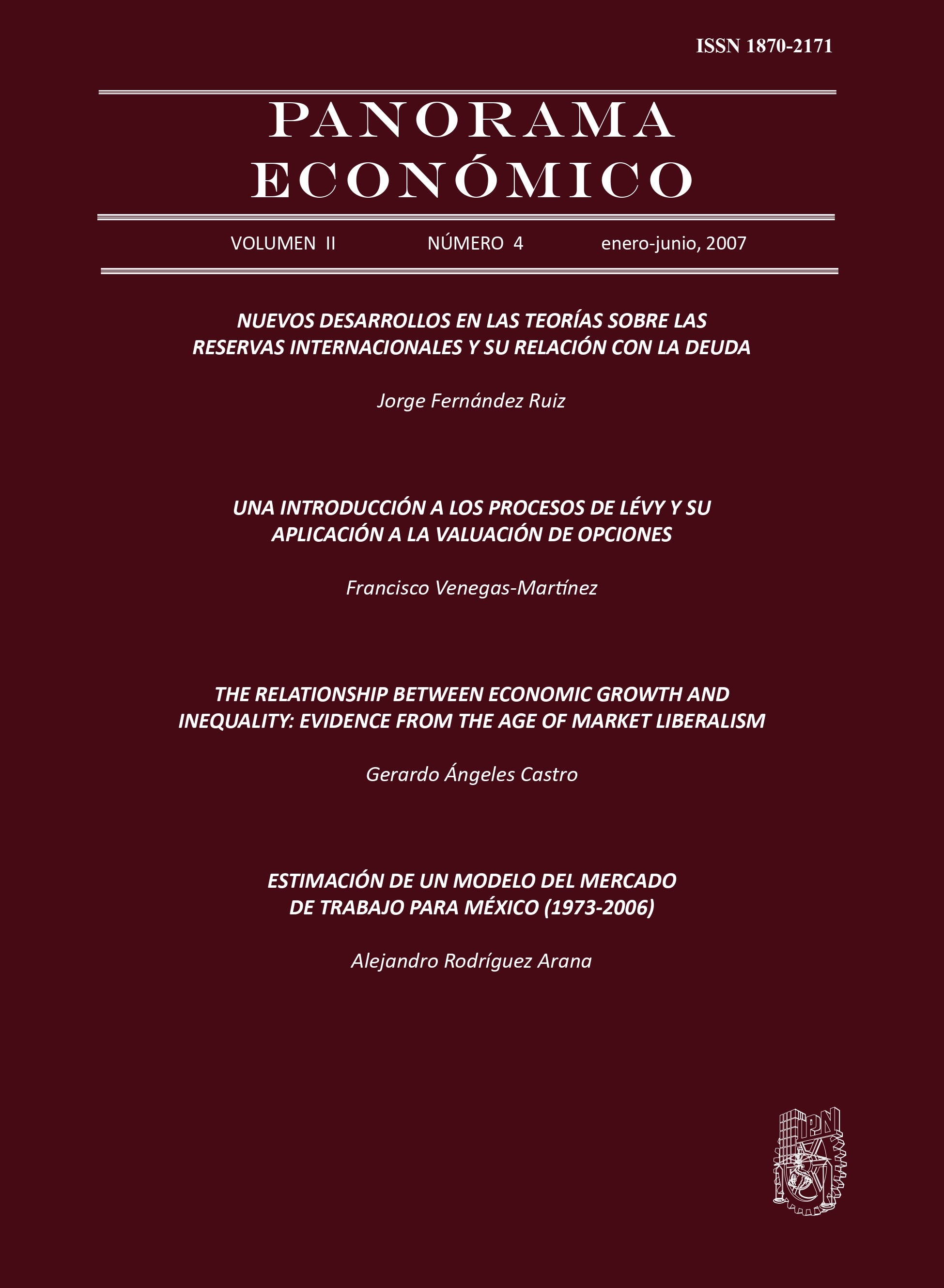The relationship between economic growth and inequality: evidence from the age of market liberalism
Contenido principal del artículo
Using a panel data set of selected countries, this paper shows that the inequality-growth relationship follows an ordinary-U curve during the period 1970-98, in which inequality first decreases and then rises with economic growth. In addition, there is some evidence that the increasing pattern may reverse at higher levels of income. A time-series approach shows that a substantial group of countries capture a minimum turning point in different years along the period and others follow a permanent positive trend. It also indicates that only a few countries reverse inequality in a latter stage and display a maximum turning point after the mid-1990s; these countries are associated with macroeconomic stability, high governance and moderate expansion of trade and FDI. Hence, the inequality-growth relationship during the era of market openness has tended to change towards a positive one, although it might reverse at a later stage.
Acemoglu, Daron (2002) – “Technical Change, Inequality and the Labour Market”, Journal of Economic Literature, 40 (1), 7-72.
Anand, Sudhir and Kanbur, S. M. R. (1993) – “Inequality and Development: a Critique”, Journal of Development Economics, 41 (1), 19-43.
Angeles-Castro, Gerardo (2006) – “The Effects of Economic Liberalisation on Income Distribution: a Panel Data Analysis”, en Eckhard Hein, Arne Heise y Achim Truger (eds.), Wages, Employment, Distribution and Growth, Palgrave Macmillan, 151-80.
Arbache, Jorge S., Dickerson, Andy, and Green, Francis (2004) – “Trade Liberalisation and Wages in Developing Countries”, The Economic Journal, 114, 73-96.
Arellano, Manuel and Bond, Stephen (1991) – “Some Tests of Specification for Panel Data: Monte Carlo Evidence and an Application to Employment Equations”, The Review of Economic Studies, 58:2, 277-97.
Atkinson, Anthony B. and Bourguignon, Francois (2000) – “Introduction: Income Distribution and Economics”, en Handbook of Income Distribution, Vol. 1, Elsevier, 2-3.
Atkinson, Anthony B. and Brandolini, Andrea (2001) – “Promises and Pitfalls in the Use of ‘Secondary’ Data-Sets: Income Inequality in OECD Countries as a Case Study”, Journal of Economic Literature, 39 (3), 771-99.
Atkinson, Anthony B., Brandolini, Andrea and Smeeding, Timothy M. (2002) – Producing Time Series Data for Income Distribution: Sources and Techniques, Syracuse University Working Paper 295.
Baltagi, Badi. H. (2001) – Econometric Analysis of Panel Data, 2ª ed., John Wiley & Sons.
Barrett, Patrick S. (2001) – “Labour Policy, Labour-Business Relations and the Transition to Democracy in Chile”, Journal of Latin American Studies, 33, 561-97.
Barro, Robert J. (2000) – “Inequality and Growth in a Panel of Countries”, Journal of Economic Growth, 5, 5-32.
Berman, Eli, Bound, John, and Machin, Stephen (1998) – “Implications of Skill Biased Technological Change: International Evidence”, Quarterly Journal of Economics, 113 (4), 1245-79.
Blundell, Richard and Bond, Stephen (1998) – “Initial Conditions and Moment Restrictions in Dynamic Panel Data Models”, Journal of Econometrics, 87, 115-43.
Bourguignon, F. (1994) – “Growth, Distribution and Human Resources”, en G. Rains (ed.), In Route to Modern Growth, Essays in Honour of Carlos Diaz-Alejandro, Johns Hopkins University Press, 43-69.
Breusch, T. and Pagan, A. (1980) – “The LM Test and its Applications to Model Specification in Econometrics”, The Review of Economic Studies, 47, 239-54.
Bruno, Michael, Ravallion, Martin and Squire, Lyn (1998) – “Equity and Growth in Developing Countries: Old and New Perspectives on the Policy Issues”, en Vito Tanzi y Ke-young Chu (eds.), Income Distribution and High Quality Growth, MIT Press, 117-46.
Bulmer-Thomas, Victor (1996) – “Introduction”, en The New Economic Model in Latin America and its Impact on Income Distribution and Poverty, Macmillan Press, 7-26.
Card, David and DiNardo, John E. (2002) – Skill Biased Technological Change and Rising Wage Inequality: Some Problems and Puzzles, NBER Working Paper 8769.
Corden, W. M. (1993) – Protection and Liberalisation: A Review of the Analytical Issues, IMF Occasional Paper 54.
Cornia, Giovanni A. and Court, Julius (2001) – Inequality, Growth and Poverty in the Era of Liberalization and Globalization, UNU/WIDER Policy Brief 4.
De Gregorio, José and Lee, Jong-Wha (2002) – “Education and Income Inequality: New Evidence from Cross-Country Data”, Review of Income and Wealth, 48 (3), 395-416.
Deininger, Klaus and Squire, Lyn (1996) – “A New Data Set Measuring Income Inequality”, The World Bank Economic Review, 10 (3), 565-91.
Deininger, Klaus and Squire, Lyn (1998) – “New Ways of Looking at Old Issues: Inequality and Growth”, Journal of Development Economics, 57, 259-87.
Doornik, Jurgen A., Arellano, Manuel and Bond, Stephen (2002) – Panel Data Estimation Using DPD for OX, CEMFI Working Paper.
Draper, Norman R. and Smith, Harry (1998) – Applied Regression Analysis, 3ª ed., John Wiley & Sons.
FitzGerald, E. V. K. (1996) – “The New Trade Regime: Macroeconomic Behaviour and Income Distribution in Latin America”, en Victor Bulmer-Thomas (ed.), The New Economic Model in Latin America and its Impact on Income Distribution and Poverty, Macmillan Press, 29-52.
Flemming, J. S. and Micklewright, John (2000) – “Income Distribution, Economic Systems and Transition”, en Handbook of Income Distribution, Vol. 1, Elsevier, 843-918.
Forbes, Kristin J. (2000) – “A Reassessment of the Relationship between Inequality and Growth”, American Economic Review, 90, 869-87.
Fosu, Augustin K. (1993) – “Kuznets’ Inverted-U Hypothesis: Comment”, Southern Economic Journal, 59, 523-27.
Galbraith, James K. and Kum, Hyunsub (2002) – Inequality and Economic Growth: Data Comparison and Econometric Tests, UTIP Working Paper 21.
Galbraith, James K. and Kum, Hyunsub (2003) – Estimating the Inequality of Household Incomes: Filling Gaps and Correcting Errors in Deininger & Squire, UTIP Working Paper 22.
Goldin, Claudia and Katz, Lawrence F. (1998) – “The Origins of Technology-Skills Complementarity”, The Quarterly Journal of Economics, 113 (3), 693-732.
Gottschalk, Peter and Smeeding, Timothy M. (2000) – “Empirical Evidence on Income Inequality in Industrial Countries”, en Handbook of Income Distribution, Vol. 1, Elsevier, 261-307.
Greene, William H. (2000) – Econometric Analysis, 4ª ed., Prentice Hall.
Griffith-Jones, S. (1996) – “International Capital Flows to Latin America”, en Victor Bulmer-Thomas (ed.), The New Economic Model in Latin America and its Impact on Income Distribution and Poverty, Macmillan Press, 127-43.
Gujarati, Damador. N. (2003) – Basic Econometrics, 4ª ed., McGraw-Hill.
Hausman, J. A. (1978) – “Specification Test in Econometrics”, Econometrica, 46, 1251-71.
Higgott, Richard (2000) – “Contested Globalisation: the Changing Context and Normative Challenges”, Review of International Studies, 26, 131-53.
Hsing, Yu and Smyth, David J. (1994) – “Kuznets Inverted-U Hypothesis Revisited”, Applied Economic Letters, 1, 111-13.
Jacobsen, Peter W. F. and Giles, David E. A. (1998) – “Income Distribution in the United States: Kuznets’ Inverted-U Hypothesis and Data Non-Stationary”, The Journal of International Trade & Economic Development, 7 (4), 405-23.
Jha, Sailesh K. (1996) – “The Kuznets Curve, a Reassessment”, World Development, 24 (4), 773-80.
Judson, Ruth A. and Owen, Ann L. (1999) – “Estimating Dynamic Panel Data Models: a Guide for Macroeconomist”, Economics Letters, 65, 9-15.
Kanbur, Ravi (2000) – “Income Distribution and Development”, en Handbook of Income Distribution, Vol. 1, Elsevier, 791-841.
Kuznets, Simon (1955) – “Economic Growth and Income Inequality”, American Economic Review, 4, 1-28.
Milanovic, Branko (1995) – Poverty, Inequality and Social Policy in Transition Economies, World Bank Policy Research Working Paper 1530.
Morrison, Christian (2000) – “Historical Perspective on Income Distribution: The Case of Europe”, en Handbook of Income Distribution, Elsevier, 217-60.
Onaran, Özlem (2004) – Life after Crisis for Labor and Capital in the Era of Neoliberal Globalization, Vienna University Working Paper 43.
Ortiz, Guillermo (2003) – “Latin America and the Washington Consensus: Overcoming Reform Fatigue”, Finance and Development, 40 (3), 14-17.
Pissarides, Christopher A. (1997) – “Learning by Trading and Returns to Human Capital in Developing Countries”, World Bank Economic Review, 11, 17-32.
Ram, Rati (1993) – “Kuznets’ Inverted-U Hypothesis: reply”, Southern Economic Journal, 59, 528-32.
Ram, Rati (1997) – “Level of Economic Development and Income Inequality: Evidence from the Postwar Developed World”, Southern Economic Journal, 64, 576-8.
Robbins, Donald. J. (1996) – HOS Hits Facts: Facts Win; Evidence on Trade and Wages in the Developing World, Harvard University Discussion Paper 557.
Singh, Ajit (2001) – Income Inequality in Advanced Economies: A Critical Examination of the Trade and Technology Theories and an Alternative Perspective, ESRC Centre for Business Research Working Paper 219.
Smeeding, Timothy M. (2002) – *Globalisation, Inequality, and the Rich Countries of the G-20: Evidence from the Luxembourg Income Study (LIS)*, Syracuse University Working Paper 48.
Tanzi, Vito and Chu, Ke-young (1998) – Income Distribution and High-Quality Growth, MIT Press.
United Nations Conference on Trade and Development (2000) – World Investment Report: Cross-Border Mergers and Acquisitions and Development.
United Nations Conference on Trade and Development (2003) – Foreign Direct Investment Database.
Williamson, John (1990) – “What Washington Means by Policy Reform”, en Latin American Adjustment: How Much Has Happened?, Institute for International Economics, 7-20.
World Bank (2002) – World Development Indicators, CD-ROM.
Detalles del artículo

Esta obra está bajo una licencia internacional Creative Commons Atribución-NoComercial-SinDerivadas 4.0.







